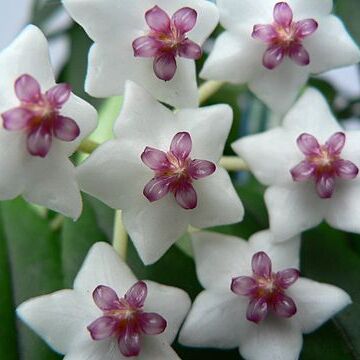Subshrubs or lianas, epiphytic or epilithic, often twining or climbing by adventitious roots. Leaves opposite, fleshy, papery, or membranous. Inflorescences extra-axillary or sometimes terminal, umbel-like, producing a succession of globose or flat-top-ped clusters; old rachis thick, with contiguous pedicel scars. Calyx small, with basal glands. Corolla fleshy, rotate, reflexed, [or campanulate]; lobes valvate, often densely hairy or scurfy inside. Corona lobes 5, depressed patent or adnate vertically to gynostegium, fleshy, glossy when dried, inner angle a tooth incumbent on anthers, outer angle rounded or acute; margin revolute, longitudinally grooved basally. Stamens short connate, apical membrane of anthers appressed against stigma head; pollinia 2 per pollinarium, oblong, erect, with raised, translucent margin. Stigma head discoid, rounded or subapiculate. Follicles often solitary, cylindric-fusiform.
Mostly epiphytic vines; stems glabrous, subligneous. Leaves thick and fleshy on usually stout petioles. Inflorescences racemose but appearing umbelliform, the rachis gradually lengthening with the flowering season. Flowers pedicellate, showy, pink, white, purple, or rarely yellow; calyx lobes small, inconspicuous, usually glabrous; corolla rotate, fleshy and often waxy-appearing, the lobes flat, convex, or sometimes reflexed, glabrous or pubescent; corona segments prominent, the lower segments appearing star-like or ascending along the sta-minal column and fleshy, the upper lobes usually in the form of an erect tooth resting against the anther, staminal column short, connivent over the stigma head; pollinia erect. Fruit a single or pair of follicles, slender or thickened, fusiform to oblong; seeds comose.

